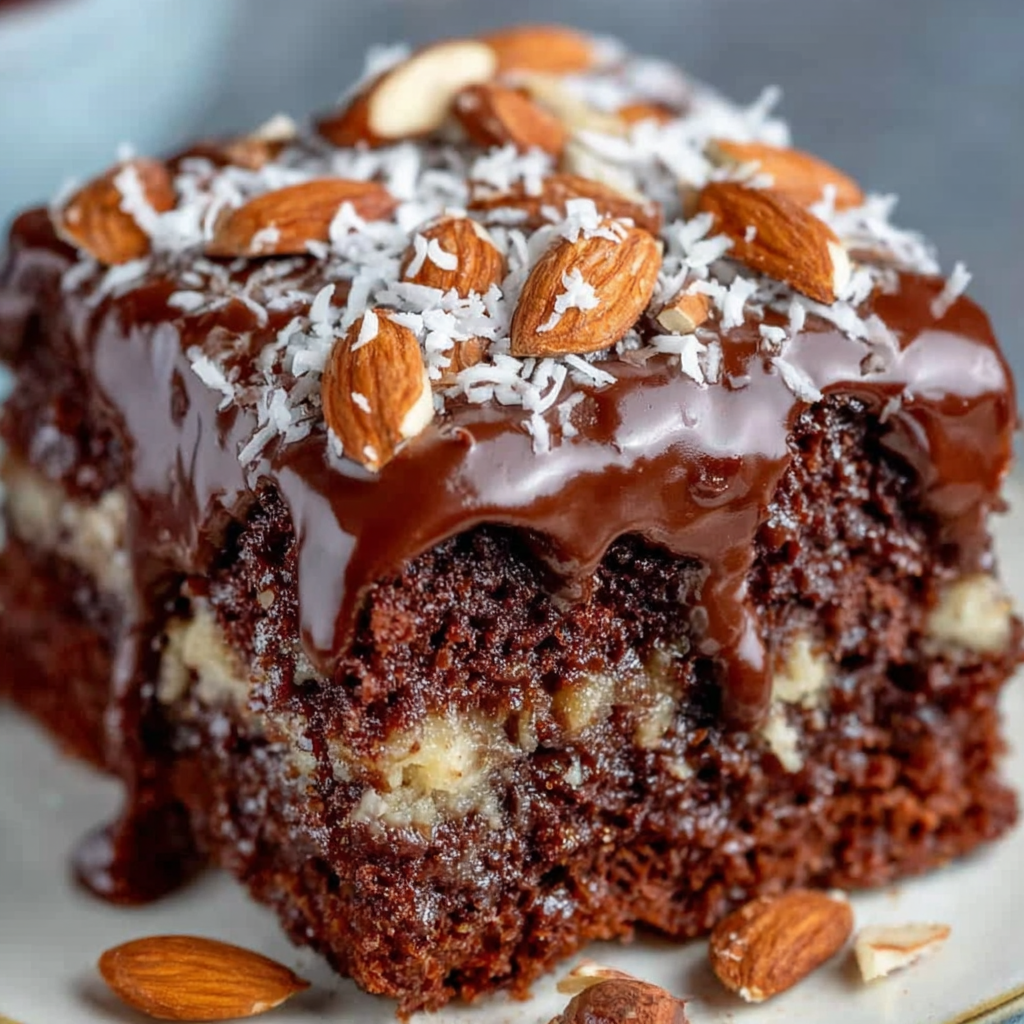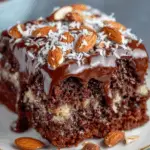If you’re seeking a show-stopping dessert that combines a moist chocolate cake base with a rich coconut frosting, look no further. This crowd-pleasing Almond Joy poke cake delivers the perfect balance of sweetness and texture, making it ideal for celebrations or cozy gatherings. In this article, you’ll learn step-by-step methods to assemble a cake that wows every palate.
By incorporating a warm coconut milk soak, each bite remains irresistibly tender. The technique of poking holes ensures full absorption, culminating in unmatched juiciness. For historical background on poke cakes, refer to poke cake techniques. Deepen your understanding of almond nutrition by exploring almond nutrition facts. To master the art of layer assembly, see our layer cake assembly guide. Enhance your flavor perspective with insights from coconut palm (Cocos nucifera), and refine your ganache with tips from chocolate ganache guide.
Roadmap:
- Origins & Inspiration: see Origins & Inspiration for the story behind poke cakes.
- Ingredient Deep Dive: ingredient measurements in Ingredient Deep Dive.
- Baking Techniques: achieve ideal texture contrast with Baking the Perfect Chocolate Cake Layers.
- Filling & Soaking: maximize moisture retention via Preparing the Coconut-Almond Filling.
For new tricks and flavor twists, visit Expert Tips, Variations & Make-Ahead Strategies.
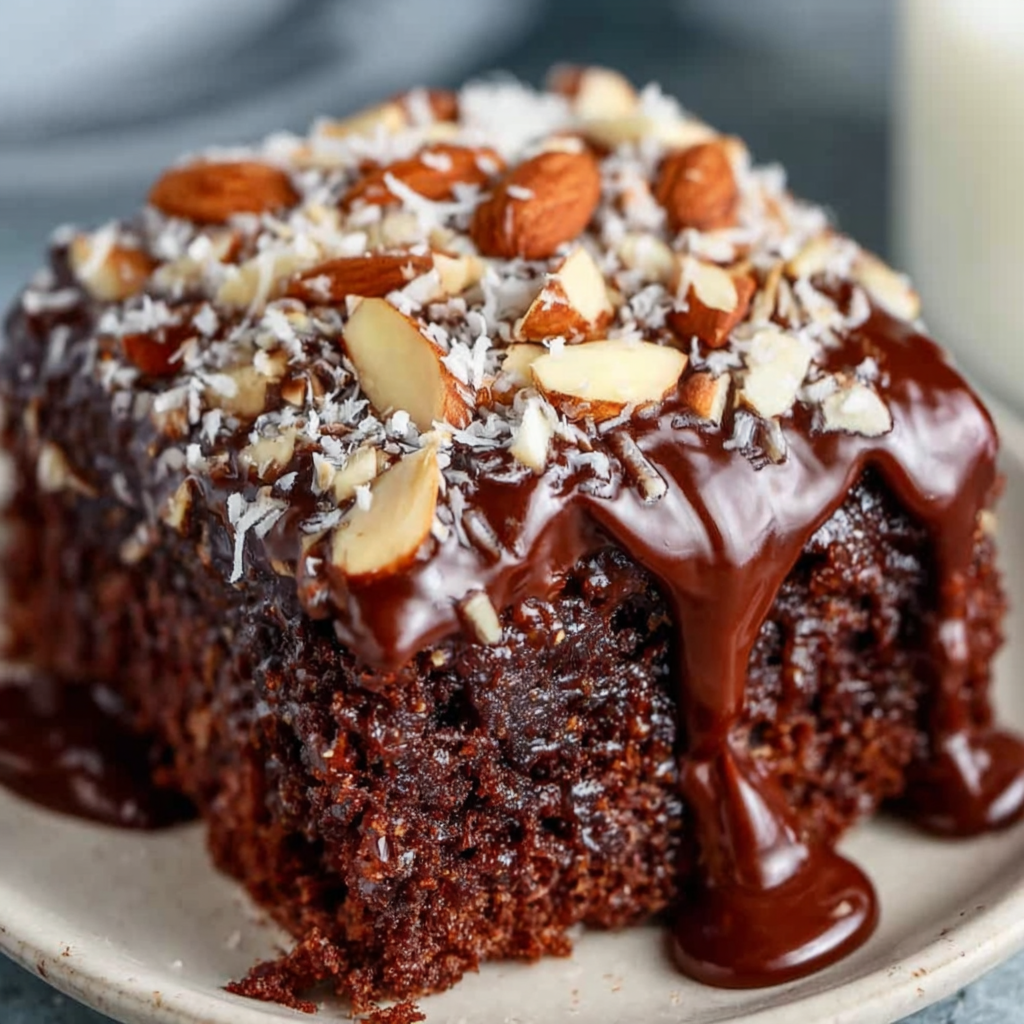
Origins & Inspiration
The poke cake concept originated in mid-20th-century America as a simple, moist dessert that revolutionized home baking. By poking holes and adding flavored liquids, bakers achieved unparalleled texture contrast and flavor infusion. Today, this technique remains a beloved staple in kitchens worldwide, including festivities.
The name “poke cake” comes from the act of using a fork or skewer to puncture the cake, creating channels for sweet syrups or custard to soak in. Explore detailed poke cake techniques and understand why this method transformed traditional layer cake assembly in our layer cake assembly guide. Bakers often rely on this method to boost moisture and taste.
Inspired by the classic Almond Joy candy bar, this version layers creamy coconut and toasted almonds atop a rich chocolate base. For additional inspiration, see almond dessert ideas and discover how coconut frosting elevates every bite. Link to Ingredient Deep Dive for detailed measurements and substitutions.
Ingredient Deep Dive
Understanding each component ensures a balanced flavor profile and perfect texture. Breaking down the recipe into its core parts allows for better ingredient selection and potential substitutions.
Chocolate Cake Base
- All-purpose flour: provides structure; for a lighter crumb, consider cake flour.
- Cocoa powder: choose high-quality dutched or natural varieties for deep chocolate intensity (see chocolate ganache guide for flavor pairing).
- Leavening agents (baking powder, baking soda, salt): ensure even rise; measure precisely.
- Oil, eggs, and milk: fat and moisture combination yields tender crumb; swap whole milk for buttermilk to enhance tang.
- Whisking technique: blend wet into dry just until combined (avoid overmixing).
Explore mixing ratios in Baking the Perfect Chocolate Cake Layers.
Coconut–Almond Filling & Ganache
- Sweetened shredded coconut: fresh vs. desiccated impacts moisture; hydrate with liquid if needed (related insights at coconut palm (Cocos nucifera)).
- Sweetened condensed milk: binds filling with creamy sweetness; learn more at sweetened condensed milk overview.
- Almond extract: a little goes a long way enhancing nutty aroma.
- Toasted almonds: gently fold to maintain crunch without releasing oils.
- Chocolate for ganache: use semisweet or bittersweet chopped chocolate heated with cream; technique details in Ingredient Deep Dive.
This breakdown supports confident ingredient choices and recipe adjustments. These NLP keywords—decadent, aromatic, luscious—highlight the dessert’s appeal. Feel free to swap coconut milk for almond milk to adjust flavor intensity or use flaked coconut for added textural variety. Check ingredient sourcing tips to ensure freshness and optimal taste profile naturally.
Baking the Perfect Chocolate Cake Layers
Creating velvety chocolate cake layers requires attention to mixing and baking techniques to achieve uniform texture and ideal crumb structure. Proper pan preparation—greasing and lining with parchment—prevents sticking and promotes even browning. Using quality ingredients ensures consistent rise and flavor and balanced texture.
The key is the two-stage mixing method from poke cake techniques. First, whisk dry ingredients—all-purpose flour, cocoa powder, baking powder, baking soda, and salt—until evenly combined. Then, beat eggs with milk, oil, and vanilla. Gently fold wet ingredients into the dry until just incorporated to avoid overdeveloping gluten and producing a dense crumb. Finally, stir in boiling water; this temperature-controlled addition thins the batter, allowing steam to lift the cake and create moist pockets as it bakes. For in-depth ratios and explanations, revisit our Ingredient Deep Dive section.
Before pouring into pans, consider these tips from layer cake assembly experts and add visual flair with guidance from chocolate cake decorating tips. Use a kitchen scale to weigh batter evenly between pans, preventing lopsided layers. Preheat your oven to 350 °F (175 °C) and rotate pans halfway through baking for uniform rise. If you crave additional inspiration, explore summer poke cake recipe inspiration or find texture-enhancing tricks via almond dessert ideas. For a coconut frosting twist, browse coconut frosting inspiration or explore coconut origin at coconut palm (Cocos nucifera).
Common challenges arise when layers dome excessively or collapse. To troubleshoot:
- Domed tops: Tap pans gently on the counter before baking to eliminate air pockets.
- Dense centers: Ensure precise leavening measurement and check oven temperature accuracy.
- Uneven bake: Use an oven thermometer and avoid opening the door too early.
- Dry edges: Insulate pan sides with cake strips or parchment collars for gentle heat distribution.
Practice these techniques to bake fluffy, even layers that serve as the perfect foundation for your coconut-frosted Almond Joy poke cake.
Preparing the Coconut-Almond Filling
A well-crafted coconut-almond filling bridges the layers with creamy sweetness and crunchy texture. This component blends sweetened shredded coconut, sweetened condensed milk, and a hint of almond extract to achieve a luscious, balanced taste. Proper mixing and ingredient temperatures are key to prevent separation or clumping.
To begin, combine the following in a medium bowl:
- 1 can (14 oz/400 g) sweetened shredded coconut
- 1 cup (240 g) sweetened condensed milk
- ½ tsp almond extract
Stir until the coconut is fully coated and the mixture is homogenous. Next, gently fold in ¾ cup (90 g) toasted, chopped almonds to introduce a crunchy contrast. Explore almond nutrition facts for health benefits and reference sweetened condensed milk overview for ingredient insights. For internal guidance on ingredient ratios, see Ingredient Deep Dive and Baking the Perfect Chocolate Cake Layers.
Maintaining the right consistency is crucial:
- Too dry: add a tablespoon of reserved coconut milk
- Too wet: incorporate additional shredded coconut or chill briefly
- Flavor boost: a dash of vanilla extract enhances depth
This filling not only adds moisture retention but also layers of nutty, tropical aroma that elevate the overall dessert experience. Chill the filling to firm up before spreading for cleaner layers and easier handling.
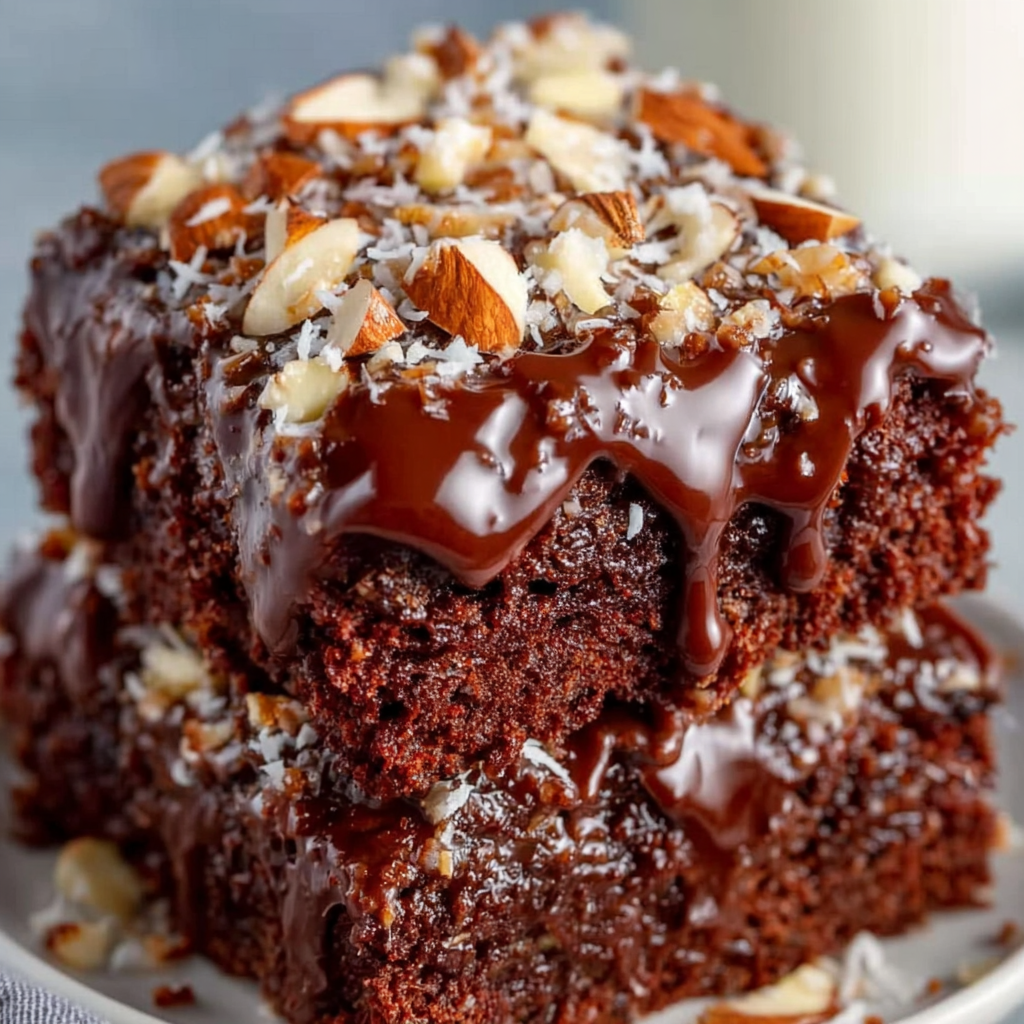
Soaking & Poking: Infusing Flavor
After baking and cooling your layers, it’s time to create those signature moist pockets that make a poke cake irresistible. Using a skewer or fork, gently puncture each layer in a grid pattern, spacing holes about 1 inch apart. This allows the coconut milk soak to penetrate fully, ensuring every bite is rich and tender.
For the soak, warm one can of coconut milk until just steaming. Slowly pour over each layer, letting liquid settle into the holes. If you prefer a lighter touch, substitute half the coconut milk with sweetened condensed milk for extra creaminess. Learn more about balancing liquid ratios in the Ingredient Deep Dive.
Allow the cake layers to rest for at least 20 minutes before assembly. This resting period gives the soak time to distribute evenly. If you’re short on time, cover layers and chill for 30 minutes in the fridge; chilling firms the cake slightly, making it easier to handle during assembly. For troubleshooting tips on avoiding sogginess, revisit our Baking the Perfect Chocolate Cake Layers.
Making & Applying the Coconut Frosting
A light, fluffy coconut frosting complements the dense soak without overwhelming it. Whip together:
- 1¾ cups heavy whipping cream
- 1 teaspoon vanilla extract
- ⅓ cup powdered sugar
- ½ cup sweetened shredded coconut (reserve extra for topping)
Begin by chilling your bowl and beaters—cold equipment helps achieve stable peaks. Beat cream and vanilla on medium-high until soft peaks form, then gradually add powdered sugar. Fold in coconut gently to maintain airiness.
To stabilize for piping or spreading, you may blend in 2 ounces of softened cream cheese or 1 tablespoon of cornstarch. This prevents collapse when the cake is at room temperature. For variations on frostings and alternative stabilizers, check our Expert Tips, Variations & Make-Ahead Strategies.
Apply frosting between layers using an offset spatula, ensuring even coverage. For decorative borders or swirls, transfer frosting to a piping bag fitted with a large star tip. Chill briefly after frosting to set before adding ganache.
Crafting the Chocolate Ganache Drip
The glossy ganache drip adds visual drama and decadent chocolate intensity. In a heatproof bowl, combine:
- 8 oz semisweet or bittersweet chocolate, chopped
- 1 cup heavy cream
- 2 tbsp unsalted butter, cubed
Heat cream until it simmers, then pour over chocolate. Let stand 2 minutes before stirring gently from the center outward until smooth. Stir in butter until melted and glossy.
Let the ganache cool to a pourable consistency—too hot and it will run off completely; too cool and it won’t drip. Test on the edge of a cooled cake dummy or parchment to gauge flow. For guidance on chocolate quality and ratios, see our Chocolate Ganache Guide.
Using a spoon or squeeze bottle, apply ganache around the cake’s edge, allowing drips to form naturally. Once the perimeter is done, pour remaining ganache atop the cake and smooth out.
Assembling & Decorating the Cake
With all components ready, assembly brings everything together:
- First Layer: Place on a cake stand or platter; add one-third of the coconut-almond filling (see Preparing the Coconut-Almond Filling).
- Middle Layer: Repeat soaking and filling steps evenly to prevent slippage.
- Top Layer & Frosting: Frost the top and sides with coconut frosting.
- Ganache Drip: Apply as above, then smooth the top.
Finish with toasted almond slices, flaked coconut, and chocolate shavings for texture and visual appeal. For advanced decorating tips, refer to chocolate cake decorating tips.
Expert Tips, Variations & Make-Ahead Strategies
- Vegan/Gluten-Free: Use almond milk-soaked flax eggs and gluten-free flour blend; swap whipped coconut cream for dairy.
- Flavor Twists: Add 1 tbsp rum or coffee extract to the soak for depth.
- Mini-Cakes & Sheet Pans: Halve or triple the recipe; adjust baking time accordingly.
- Make-Ahead: Bake layers up to 2 days ahead; wrap and freeze. Prepare filling and ganache in advance. Thaw layers at room temperature before assembly.
Benefit from our Summer Poke Cake Inspiration gallery for seasonal twists.
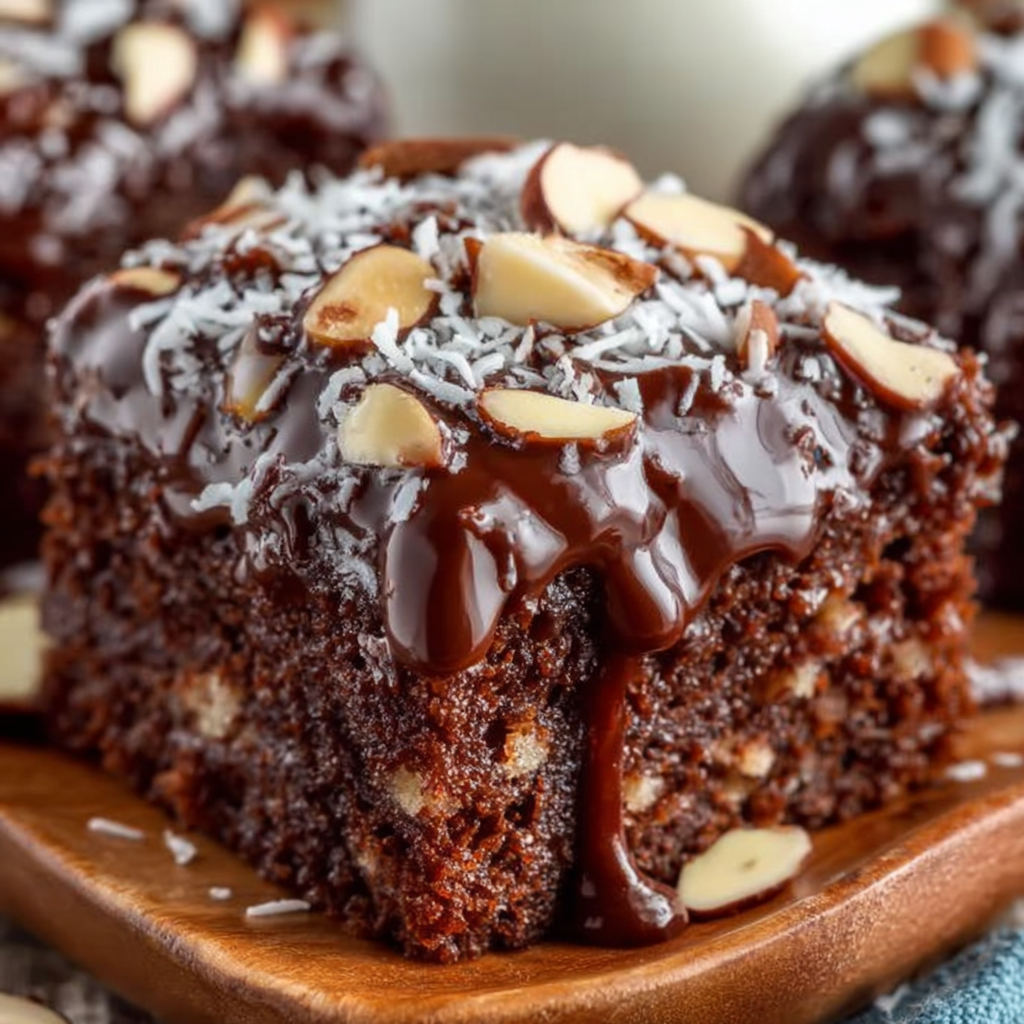
Frequently Asked Questions (FAQs)
What is a poke cake?
A poke cake is a dessert where holes are poked into baked layers, then filled with syrup, pudding, or in this case, coconut milk, to enhance moistness and flavor.
Can I use unsweetened shredded coconut instead of sweetened?
Yes. If using unsweetened, increase sweetened condensed milk by 2 tbsp or add 1–2 tbsp powdered sugar to maintain sweetness.
How do I prevent my poke cake from becoming soggy?
Use warm—but not boiling—liquid for the soak, and allow cake to rest so excess pools are absorbed rather than sitting on top.
Can I prepare this cake a day ahead?
Absolutely. Assemble 1 day prior, cover tightly, and refrigerate. Remove 30 minutes before serving to reach ideal texture.
What’s the best way to store leftovers?
Cover with plastic wrap or in an airtight container. Refrigerate for up to 4 days; bring to room temperature before serving for best flavor.
How to Make the Best Almond Joy Poke Cake with Coconut Frosting
A luscious Almond Joy poke cake that layers a rich chocolate base with a warm coconut milk soak, creamy coconut-almond filling, light coconut frosting, and a glossy chocolate ganache drip. Finished with toasted almonds and coconut flakes, it’s both visually stunning and decadently flavorful—perfect for birthdays, holidays, or any gathering.
Ingredients
For the chocolate cake layers:
- 2 cups (250 g) all-purpose flour
- 1¾ cups (350 g) granulated sugar
- ¾ cup (75 g) unsweetened cocoa powder
- 1½ teaspoons baking powder
- 1½ teaspoons baking soda
- 1 teaspoon salt
- 2 large eggs, room temperature
- 1 cup (240 ml) whole milk or buttermilk
- ½ cup (120 ml) vegetable oil
- 2 teaspoons vanilla extract
- 1 cup (240 ml) boiling water
For the coconut-almond filling:
- 1 can (14 oz/400 g) sweetened shredded coconut
- 1 cup (240 g) sweetened condensed milk
- ½ teaspoon almond extract
- ¾ cup (90 g) chopped whole almonds, toasted
For the chocolate ganache topping:
- 8 oz (225 g) semisweet or bittersweet chocolate, chopped
- 1 cup (240 ml) heavy cream
- 2 tablespoons unsalted butter, softened
Instructions
• Preheat oven to 350 °F (175 °C). Grease three 8-inch round cake pans and line bottoms with parchment circles.
• In a large bowl, whisk together flour, sugar, cocoa powder, baking powder, baking soda, and salt until uniform.
• In a separate bowl, beat eggs with milk (or buttermilk), oil, and vanilla until combined. Pour wet ingredients into dry and stir until no streaks remain.
• Carefully pour in boiling water and whisk until batter is smooth (it will be thin).
• Divide batter evenly among the three prepared pans. Bake for 25–30 minutes, or until a toothpick inserted into the center comes out with a few moist crumbs.
• Let cakes cool in pans for 10 minutes, then invert onto wire racks to cool completely.
• While cakes bake, prepare the filling by stirring together shredded coconut, sweetened condensed milk, and almond extract until evenly coated. Fold in the toasted almonds.
• Place first cake layer on serving plate. Spread one-third of the coconut-almond filling over the top. Repeat with second layer and another third of filling. Top with third cake layer.
• In a small saucepan, heat cream over medium until it just begins to steam. Remove from heat and pour over chopped chocolate in a heatproof bowl. Let sit 2 minutes, then whisk gently until smooth. Stir in softened butter until glossy.
• Let ganache cool slightly until pourable but no longer steaming. Pour over top of assembled cake, letting ganache drip down the sides.
• Refrigerate cake for at least 2 hours to set. Bring to room temperature before slicing.
Notes
-
For extra almond aroma, toast almonds until golden-brown and cool completely before chopping.
-
Use a cake leveler to ensure even stacking.
-
If ganache sets too firm, gently microwave small portions (5–10 seconds) to soften for drizzling.
-
To reduce sweetness, substitute half the sweetened condensed milk with coconut cream.
-
Experiment with garnishes like edible flowers or tropical fruit slices for a personalized touch.
